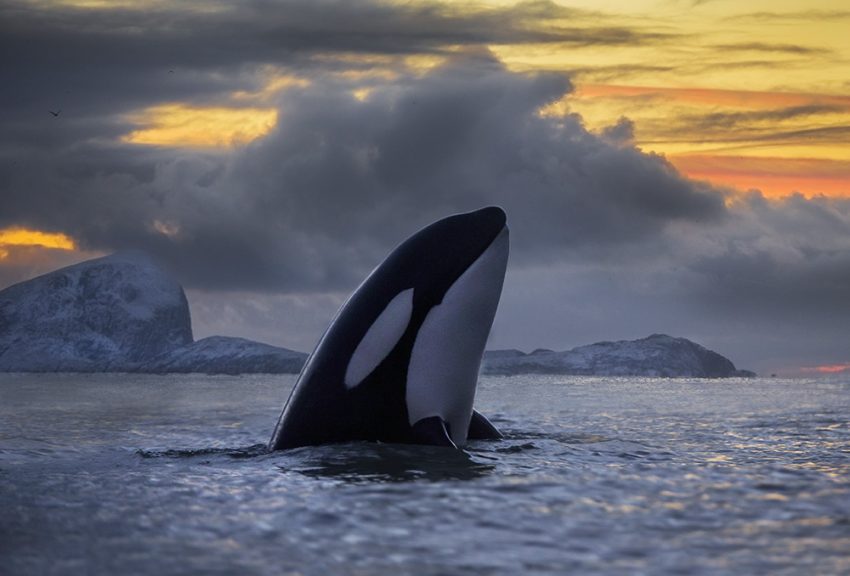Pollution puts orcas at risk Published 02.10.2018

Many orca populations worldwide are endangered. The reason is high levels of PCB, which can pro-duce sterilisation, hormone disorder, impaired immune system and increased mortality. Orcas in the Tasiilaq area in East Greenland are among the most contaminated populations, and scientists discour-age eating of these.
At least half of 19 populations of orcas (Orcinus orca) included in a global survey are at risk of extinction within the next 30-40 years. The orcas caught at Tasiilaq are among these. The reason is the accumulation of the chlorine-containing environmental contaminants PCBs in the orcas’ bodies. Despite the facts that the use of PCBs in some countries has been prohibited since the 1970s and 90 countries through the so-called Stockholm Convention in 2004 ratified a ban on the direct discharge of PCBs, it is not easy getting rid of these toxic chemicals. Orcas have accumulated so much PCB that the most exposed orcas living in the oceans around heavily industrialised countries are expected to be sterile.
This is the claim in an article published today in the renowned scientific journal Science, written by a group of scientists from USA, Canada, England, Iceland, Denmark and Greenland. Senior scientist Aqqalu Rosing-Asvid from the Greenland Institute of Natural Resources is co-writer of the article.

East Greenlandic orcas are also contaminated
Among the most important determining factors for the PCB level in fish and marine mammals are how close they live to polluting sources (typically industrialised countries), how high they rank in the food chain, how much they eat, and how old they become. Though the Arctic is far from the pollutants, much is transported north with the ocean currents, in the air and in organisms swimming or floating north. Typically, PCBs and certain other pollutants accumulate and concentrate many times for each link in the food chain, which is why seals, polar bears and toothed whales usually have very high concentrations of these chemicals. Polar bears rank a link higher than seals, and in East Greenland they have PCB levels approx. 10 times higher than ringed seals. The East Greenlandic orcas, however, have concentration levels approx. 100 times higher than ringed seals. This is partly due to the fact that orcas grow old (often 60-70 years or older), so many of the now-living individuals also lived at a time when the level of pollution was higher, and they continue to accumulate PCBs.
The orcas that have arrived to the Tasiilaq area since 2009 are genetically indistinguishable from the fish-eating orcas that live off the coasts of Iceland and Norway. The East Greenlandic orcas also seem to eat a lot of fish, but apparently marine mammals have become their main source of feed. In any case, all the surveyed orcas from the Tasiilaq area have been preying on marine mammals, and they are much more contaminated with PCBs than the fish-eating orcas.
Pollution levels are disturbingly high
The high contamination levels of the East Greenlandic orcas worry the scientists behind the article in Science, and they advice that people do not consume meat from the orcas.
“Our surveys show that the efforts that have been made to avoid PCBs from accumulating at the highest trophic levels (higher in the food chain) have not been efficient enough. Therefore, there is a pressing need to follow up on the initiatives of the Stockholm Convention,” concludes co-writer of the article Paul D. Jepson from Institute for Zoological Society of London.
The contamination levels of the East Greenlandic orcas are thought to be so high that it will impair reproductivity and increase mortality. Thus, the new study questions the long-term survival of these marine mammal-feeding orcas as well as several populations of the fish-eating orcas living in industrialised areas.
In East Greenland 43 catches of orca have been reported between 2009-2017, to which must be added an unknown number of orcas that are either hurt or dead without being landed. The results from the new study indicate, however, that these whales will not be able to produce a surplus, which could support sustainable catch.
For more information, please contact:
Senior scientist at the Department of Birds and Mammals, Aqqalu Rosing-Asvid, by phone +299 361200 or e-mail aqro@natur.gl.

